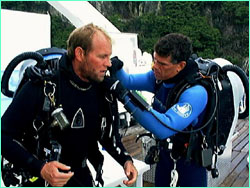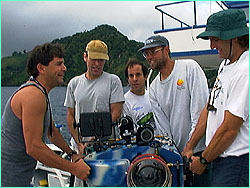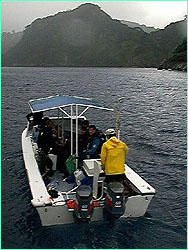 |
 |
 |
by Peter Tyson September 29, 1998 There's a splash as second assistant Mark Thurlow falls backward into the water. He's followed momentarily by director-cinematographer Howard Hall and first assistant Bob Cranston. All three wear 80-pound rebreathers, a specialized type of scuba gear whose chief benefits to underwater filmmakers are increased bottom time and an absence of bubbles, which can frighten fish. The final shooting expedition for the IMAX film "Island of the Sharks" has officially begun. As the rest of the film crew waits for them to descend to the bottom, I look around and get my bearings. We're off the west side of Manuelita Island (see Explore the Island). At Bajo Alcyone, our first choice for this morning's inaugural shoot, the visibility was too poor, and at Dirty Rock, our second choice, the current proved too strong. So we've settled on Manuelita. Its vertical cliffs rise overhead. Wherever the angle of inclination is less than 90 degrees, tufts of grass and bushy, mangrove-like trees cling to the lava face, their long roots dangling in the air like stringy hair. Every piece of vegetation, it seems, holds a bird, either a brown or red-footed booby, a downy booby chick, or a snow-white fairy tern. The cliffs plunge straight down into the sea a few wave lengths from our two pangas, the Undersea Hunter's 22- and 24-foot skiffs. Just to the south, Cocos Island rears overhead, a mountain shrouded in cushiony clouds. Through the light rain sweeping horizontally across Weston Bay and into our faces, I can see perhaps half a mile inland before the ubiquitous green gives way to a soft, obscuring white. Closer in, veils of streaky clouds reveal a downpour, while on the island's periphery, waterfalls spill down cliffs many stories high. Cocos has but three ingredients: green plants, gray stone, and clear water. Overall, the island on a wet day like today looks like some great green ice-cream cake in full melt.
"Roger that," replies Mark Conlin, face pressed close to the intercom. "Lance is coming down with the camera." He speaks slowly and enunciates every word; there's a hundred feet of turbulent water between him and Hall. Seconds later, Lance Milbrand is in the water, scuba-ready, and IMAX specialist Billy Holdson is swinging the 250-pound camera over the port gunwale with the help of a miniature crane mounted on the deck. On the camera's aluminum chassis, which is spray-painted in camouflage blue, Hall has affixed in black tape the word PIG. It stands for "Ponderous IMAX Gizmo." As Milbrand vanishes out of sight with the camera, Peter Kragh settles on the bow of the other boat with producer Michele Hall. Kragh palms a yellow cable that angles into the depths. At the other end of that cable lie three sealed- beam, 650-watt tungsten lamps, which Hall will mount onto the camera or have Cranston hold off to one side to light the scene. Meanwhile, Jose Luis "Pepe" Monge Garcia and Reiner Solano Cambronero, our Costa Rican drivers, deftly hold the pangas in position above the submarine film crew. Milbrand soon reappears in a burst of bubbles. He climbs the ladder onto our panga and immediately switches to a fresh scuba tank. He's only used up a small portion of his air, but he has to be ready with a full tank whenever Hall calls him back down, for he never knows what tasks he'll have to perform. Once or twice, he says, he's come unnervingly close to running out of air. The intercom crackles again. "Surface here," Conlin says. "Go ahead, Howard." Hall's strangely high-pitched squawking is incomprehensible to me, but Conlin has been doing this for ten years. "Roger that, we'll head back towards Cocos. Pepe!" Conlin signals to Monge in the other boat to put it in reverse and move south along Manuelita. Apparently the pangas are in danger of being in the shot.
Hall can also use this system to converse with his assistants, Cranston and Thurlow. But the threesome have found it much easier to simply grunt through the rebreather mouthpiece. "It's very Neanderthalesque," Conlin tells me. "When I'm down there, I have no idea what they're saying, but they do, and that's all that counts." Now that Hall has the PIG, we settle in for a long wait. It usually takes Hall an hour and a half to shoot a single three-minute roll of IMAX film. To replace a roll, the camera must be brought to the surface, where Holdson stands by ready to reload and give the camera a once-over before sending it back down with Milbrand or Conlin (who periodically switch jobs). But the visibility is not great even here, and within 45 minutes, Hall's disembodied voice again is heard over the intercom. "Roger, copy that," Conlin says carefully. "You are done and would like Lance to get the camera. He is on his way down. Is it okay to let Michele and Peter dive now?" That's what I've been waiting for. I feel privileged to have witnessed The Process, but now it's time to hit the water. Peter Tyson is Online Producer of NOVA. Hammerheads or Bust (Sept. 23) Get Used To It (Sept. 25) Nature Reigns at Cocos (Sept. 27) The PIG and the Process (Sept. 29) Hammerheads Sighted (Oct. 1) Assault on Cocos (Oct. 3) The Director's Cut (Oct. 5) Swimming with Whitetip Reef Sharks (Oct. 7) The Magnificent Seven (Oct. 9) The Search for Lake Cocos (Oct. 11) Courtship of the Marbled Rays (Oct. 13) Of Booby and Beebe (Oct. 15) Taken by Surprise (Oct. 17) "This is Cocos, This is Cool" (Oct. 19) Cocos Island | Sharkmasters | World of Sharks | Dispatches E-mail | Resources | Site Map | Sharks Home Editor's Picks | Previous Sites | Join Us/E-mail | TV/Web Schedule | About NOVA Watch NOVAs online | Teachers | Site Map | Shop | Search | To Print PBS Online | NOVA Online | WGBH © | Updated June 2002 |
 Bob Cranston and Howard Hall prepare their rebreathers.
Bob Cranston and Howard Hall prepare their rebreathers.

 The first panga heads out along Manuelita.
The first panga heads out along Manuelita.